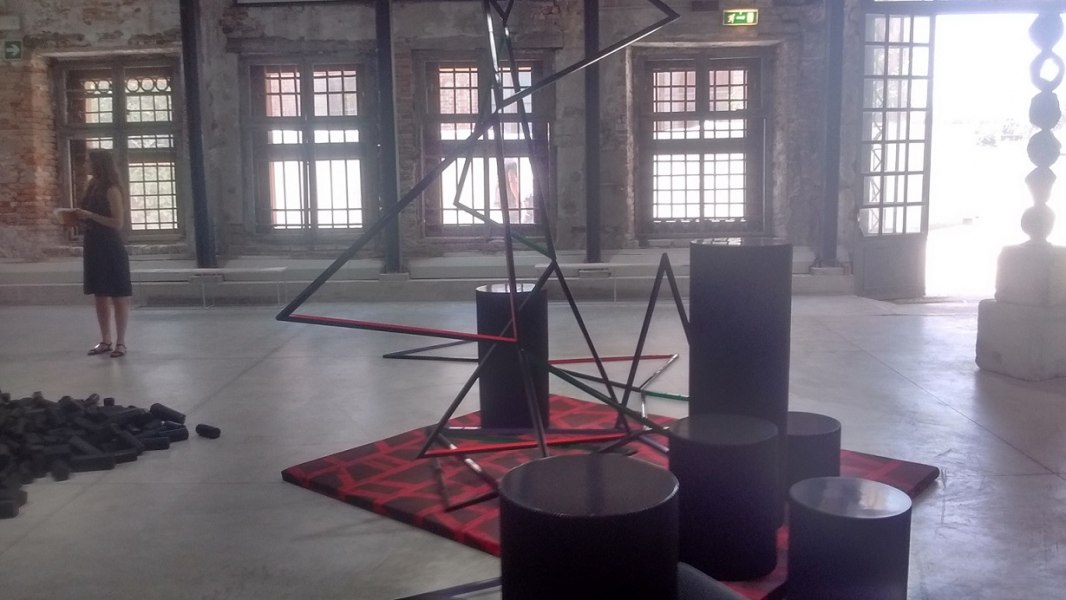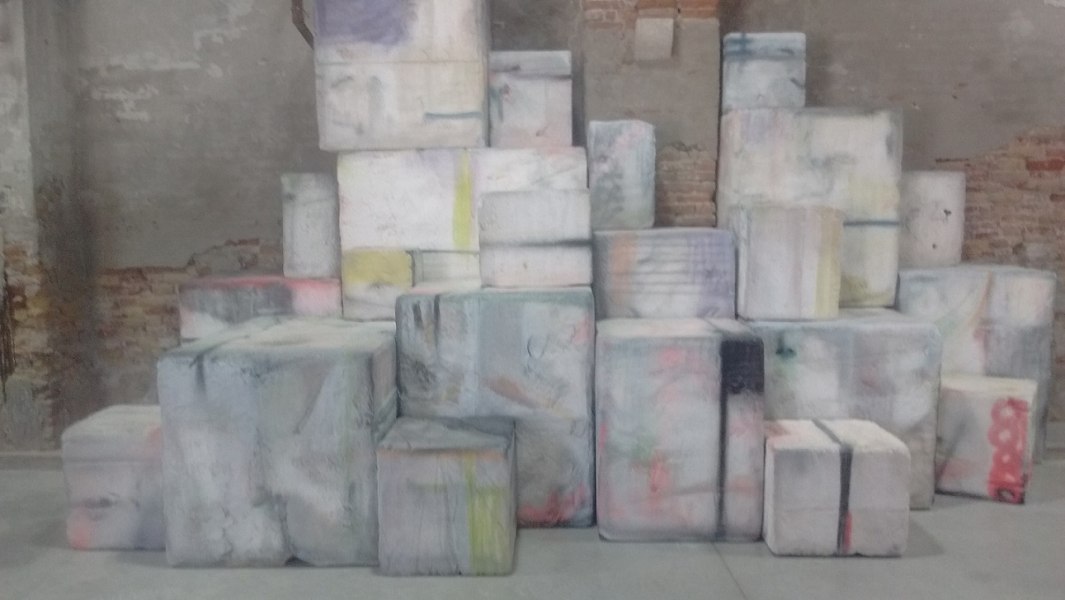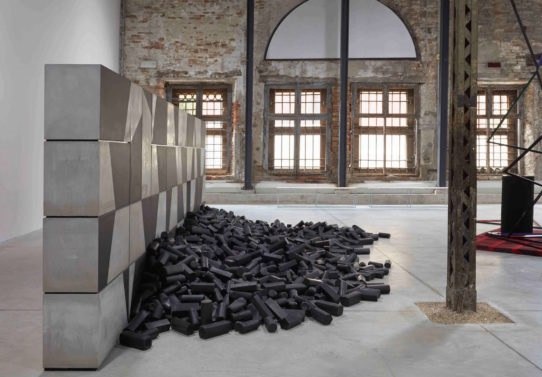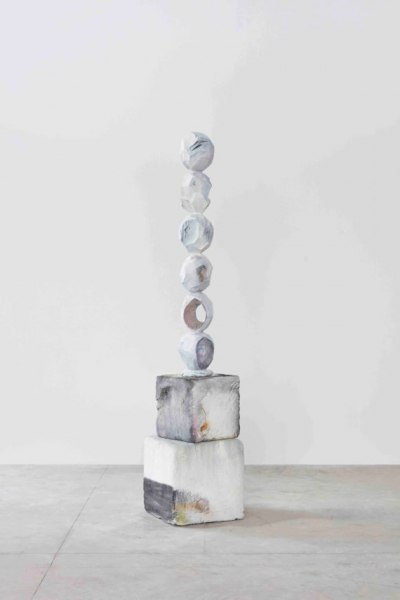Alla Biennale di Venezia, è stato aperto il Padiglione Nazionale dell’Irlanda, avente le installazioni dell’artista Eva Rothschild. Esteticamente a lei interessa il geometrismo irregolare, in origine proposto da Constantin Brancusi. Dunque la forma non riesce ad assumere un “ruolo preciso”, rispetto all’ambiente circostante. Negli allestimenti di Eva Rothschild, la comodità del modernismo manderà in oscillazione la cinestesia dell’occupazione. Per la monumentalità, ci sarà il guadagno d’una ricombinazione. Uno sguardo si pone in modo flessuoso, alla sua occupazione dei limiti spaziali. A Venezia, l’artista tiene ravvicinati alcuni raggruppamenti di sculture. Si percepisce un’architettura “sulla difensiva”: fra il blocco, il disturbo, l’illusione ecc… Così è difficile occupare, e roviniamo sull’ansia d’una modernità che ci raggruppa per flessibilità. La monumentalità serve a preservare il ricordo d’una precisione all’assunzione d’una responsabilità, per finalità sociali, rispetto all’ambiente di vita. Ciò è reso più “comodo” dal modernismo, e sino ad accettare in estetica il minimalismo. Ma la tecnologia ha una crescita volta all’oscillazione, illudendoci di vivere in una realtà globale. E’ la “franosità” del ricombinare, che per Eva Rothschild va osservata senza prevaricazioni. Ci “si difende” dalla flessibilità solo dialogando con le sue circostanze. In questo modo, ad esempio, la tecnologia dovrebbe “sposare” l’ambientalismo. L’artista lascia che gli ostacoli delle sue installazioni siano arginabili, perché ogni separazione dà una comodità apparente, se il progresso avanza. A Venezia, la mostra s’intitola The shrinking universe. Questo è forse un monito, perché il farsi scudo in se stessi, da parte di ciascun popolo, spinge qualunque problema a “spezzettarsi”, nella sua irrimediabilità. Ovviamente ci resta la tensione, se non abbiamo ancora preso l’abitudine con la latenza d’una flessibilità imprevedibile.
Per Giuseppe Ungaretti, il mughetto diventa il calice del candore. Quello simboleggerà l’innocenza dei bambini, sull’altalena del cielo. Gli adulti perdono la purezza iniziale, massimamente facendosi la guerra. Un “brindisi” alla vita dei bambini positivamente non è “di vittoria”, bensì “solo per gioco”. L’installazione di Eva Rothschild dal titolo Spektor ci mostra una colonna, virtualmente avente uno “spiedino” di teste. Così un’architettura umana potrà oscillare come un arco, raggruppando la flessibilità dei suoi “abbracci”. Normalmente il vuoto subisce la negatività del restringimento. C’è anche la sua conclusione nello spettro. Qualcosa che porterà lo “scudo” della corporalità al “calice” d’una trasfigurazione. Lo spettro è percepibile “al sorseggio” dell’atmosfera. Eva Rothschild monta lo pseudo-totem sopra un basamento in cubetti. Tutta la cordialità del cocktail non avrà completamente celato la sua tensione per il consumo…Quindi dovremo simbolicamente chiederci quanto la “flessibilità” del lavoro potrà arginare il “restringimento” dell’ambiente. Siamo “bravi” a costruire certi muri fra i popoli… Ma nel contempo non “cavalchiamo” mai le “onde anomale” per la natura che in latenza “svuota” il mondo, col suo surriscaldamento! L’installazione dell’artista assurgerà al ruolo, che ci è negativamente ignoto, d’una Cassandra per “colonnina” sulla flessibilità fuori norma dell’ambiente. Il tono del bianco, misto a quello del grigio, non dà una grande purezza.
L’installazione dal titolo Princess è più complessa, giocando sulle forme primarie del rettangolo (a pedana), del triangolo (a telaio) e del cerchio (a cilindro). Sul loro ostacolo, il visitatore non potrà accedere. Sembra che i cilindri “si strozzino” il risuono armonico, alzati diversamente. In tono nero, essi manterranno una pesantezza tale da “difendersi” al “compattatore” sui bidoni. Nulla di sinestetico, in riferimento alle percussioni. Se anche un visitatore si sedesse sui cilindri, egli poi inciamperebbe sui triangoli, fitti e decostruttivistici. Forse sarà una “franosità” per le ideologie, ricordando il famoso geometrismo di Vladimir Tatlin? Certo i triangoli non riescono a “veleggiare”, oppure rifrangono in modo solo confuso, dai loro prismi. Ci pare che nell’insieme avvenga una levata di scudi. Essi saranno sconfitti dai miraggi sulla pedana, complice il suo seminato. O forse diventa un’installazione pericolosamente di scorie? Il noto simbolo della radioattività ha il “miraggio” curvilineo del trifoglio, fra il triangolo ed il cilindro. Sulla pedana si può “sorseggiare” unicamente fino a seccarsi le labbra. Ogni visitatore immaginerà a piacimento i ruoli dei simbolismi, per tali rifrazioni.
Nella scultura dal titolo Amphi, i blocchi in legno e vetroresina sono stati incastrati in maniera chiaramente architettonica. Vi percepiamo anche il “sorseggio” a tinte “sporche” del writer metropolitano. I visitatori saranno spinti se non a scomporre i cubi quantomeno ad usarli per sedersi. Esce la miniatura d’un anfiteatro (confermando l’interesse dell’artista per l’abbraccio della visione). Resta da chiedersi quanto la flessibilità dei cubi, in uno spettacolo oltre il banale ghiaccio da cocktail, permetta positivamente la catarsi del visitatore. Al muro associamo politicamente il simbolo della divisione. E’ un’inquietudine che trapela dall’installazione Drift, in cui le decine di “tizzoni”, ormai freddamente bruciati ed in tono nerissimo, aggiungono la franosità latente delle scorie. In alto, il muro ha il disegno d’un geometrismo che tiene pericolosamente occupato il visitatore, a livello quasi “ipnotico”.
Recensione estetica per il Padiglione Nazionale dell’Irlanda – Biennale di Venezia 2019
THE COMFORT OF A MODERNISM
THAT HYPNOTIZES THE KINESTHESIA OF AN OCCUPATION
At the Venice Biennale 2019, the National Pavilion of Ireland was opened, having the installations of artist Eva Rothschild. Aesthetically, she is interested in irregular geometrics, originally proposed by Constantin Brancusi. So the shape is not able to take a “precise role”, respect the surrounding environment. In the installations of Eva Rothschild, the comfort of a modernism will cause a swinging for the kinesthesia of an occupation. In the case of the monumentality, this one will gain a recombination. A gaze is extended in limber way, when it occupies its spatial limits. In Venice, the artist allows an approach between some grouping of sculptures. We perceive an architecture “on the back foot”: between the block, the bother, the illusion etc… In this way we have difficulty in occupying, and we ruin on the anxiety of a modernity that gather us for a flexibility. The monumentality serves to preserve the memory of a precision when we take a responsibility, for social purposes, respect the living environment. This situation becomes more “comfortable” by the modernism, until it accepts aesthetically the minimalism. However the technology has a growth that tends to a swinging, deceiving ourselves that we live in a global reality. This is the “landslide” of a recombination, that according to Eva Rothschild has to be observed without abuse of power. We can defend us from the flexibility only if we dialogue with its circumstances. In this way, for example, the technology should “embrace” the environmentalism. The artist allows the obstacles of her installations to be dammed, because every separation gives an apparent comfort, if the progress advances. In Venice, the exhibition is called The shrinking universe. This is perhaps a warning, about every population shielding itself, until it leads whatever problem to “be divided into pieces”, in its irreparability. Of course we remain with the tension, if we still not have made a habit of the latency of an unpredictable flexibility.
According to poet Ungaretti, the lily of the valley becomes the stem glass of whiteness. That will symbolize the innocence of kids, on the seesaw of sky. Adults lose the initial purity, mainly with their wars. A “toast” to the life by kids positively is not for “a victory”, but “only for fun”. The installation of Eva Rothschild called Spektor shows us a column, virtually having a “meat skewer” of heads. So a human architecture could swing like a bow, gathering the flexibility of its “embraces”. Normally the vacuum suffers the negativity of a shrinkage. There is also its conclusion into a spectre. Something that will lead the “shield” of a corporality to the “goblet” of a transfiguration. A spectre can be perceived “at the sip” of an atmosphere. Eva Rothschild assembles a pseudo-totem over a base in cubes. All the cordiality of the cocktail will not have completely hidden its tension for a consuming… So we will symbolically have to ask ourselves how much the “flexibility” at work could dam a “shrinkage” of the environment. We are good at building some walls between the populations… But in the same time we never “ride” the “rogue waves” for the nature which in latency “empties” the world, with its overheating! The installation of the artist will take the role, that is negatively unknown by us, of a doomsayer as a “bollard spotter” on the unconventional flexibility of the environment. The white tone, mixed to the grey tone, does not guarantee a great purity.
The installation called Princess is more complex, “playing” with the primary shapes of the rectangle (as platform), the triangle (as framework) and the circle (as cylinder). On their obstacle, the visitor can not access. It seems that the cylinders “choke” their harmonic reverberation, while they are differently raised. In black tone, those will maintain a heaviness such as to allow its “defence” against a “compactor” on the bins. That is nothing synaesthetic, in reference to the percussions. Also if a visitor would sit on the cylinders, then he would trip on the triangles, thick and in deconstructivism. Maybe there will be a “landslide” for the ideologies, remembering the famous geometrics of Vladimir Tatlin? Of course the triangles are not able to “sail”, or rather they refract in a way only confused, through their prisms. It seems to us that overall a general outcry happens. Something that will be defeated by the mirages on the platform, complicit its marble chips. Or rather does the installation become dangerously about some scoria? The known symbol of the radioactivity has the curvilinear “mirage” of a clover, between the triangle and the cylinder. On the platform we can “sip” only until the lips are dried out. Every visitor will imagine at will the roles of the symbolisms, about the above-mentioned refractions.
In the sculpture called Amphi, the blocks in wood and fiberglass were wedged in a way clearly architectural. There we also perceive the “sip” in “dirty” tones of a metropolitan writer. The visitors would be led maybe not to decompose the cubes but at least to use these to sit. The miniature of an amphitheater comes out (confirming the interest of the artist for the embrace of a vision). The question remains how much the flexibility of the cubes, for a show beyond the banal ice for cocktails, allows positively a catharsis for the visitor. We connect politically the symbol of the division to the wall. This is an anxiety that transpires from the installation Drift, where dozens of “embers”, by now coldly burnt and in very black tone, add the latent landslide of the scoriae. Above, the wall has the drawing with a geometrics that keeps dangerously the visitor busy, in a level almost “hypnotic”.
Aesthetics review for the National Pavilion of Ireland – Venice Biennale 2019








